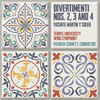Divertimenti Nos. 2, 3 and 4 by Vicente Martín y Soler
Classical composer Vicente Martín y Soler (1754–1806), sometimes called “The Spanish Mozart,” was born in Valencia, Spain but spent much of his musical life in Vienna. A contemporary of Mozart’s, he wrote a 1786 opera entitled Una Cosa Rara. While the opera has fallen into obscurity, it was immensely popular at the time of its premiere, garnering seventy-eight performances and the favor of Emperor Joseph II during its initial run at the Burgtheater in Vienna. The music became so recognizable that Mozart even quoted it in the final scene of Don Giovanni. As was customary with many popular operas in 1780s Vienna, music from Una Cosa Rara was transcribed for harmonie ensemble (pairs of oboes, clarinets, horns, and bassoons) by Johann Nepomuk Wendt. In 1795, nearly ten years later, Martín y Soler himself composed a set of six divertimenti based on themes from Una Cosa Rara. Four of the divertimenti are for winds alone, while the other two utilize strings. While it is unknown exactly why Martín y Soler composed these divertimenti, two characteristics distinguish them from Wendt’s transcription: the use of basset horns instead of B-flat clarinets, and the use of some original musical material (not from the opera), mostly in fourth movements.
Until recently, only one of these divertimenti (No. 6) was published and commercially available. The other five existed only as manuscript parts in the British Library. These editions of Divertimenti Nos. 2, 3, and 4 were published by Boosey and Hawkes in their Windependence series in 2020. It is the hope of the editor that the availability of these editions will allow more people to become familiar with this composer and his music.
The tables below outline each movement of the Divertimenti, along with their corresponding numbers in the opera Una Cosa Rara.

